Vital Seasonal Aspects Of Commercial Exterior Paint: What You Should Comprehend
Vital Seasonal Aspects Of Commercial Exterior Paint: What You Should Comprehend
Blog Article
continue reading this Created By-Fox Whalen
When you're planning an industrial outside paint task, seasonal variables can make or break your results. You'll intend to consider how temperature and moisture influence paint application and drying out times. Selecting the appropriate period can guarantee your paint sticks correctly and lasts longer. Yet which seasons are truly the best for this type of job? Allow's check out the crucial elements that can influence your project's success.
The Impact of Temperature Level on Paint Application
When you're preparing a commercial exterior paint project, the temperature can considerably affect exactly how well the paint adheres and dries.
Preferably, you intend to paint when temperature levels vary in between 50 ° F and 85 ° F. If it's as well cold, the paint might not treat properly, leading to problems like peeling off or breaking.
On the other hand, if it's also hot, the paint can dry out too rapidly, preventing appropriate adhesion and resulting in an irregular coating.
You should also consider the moment of day; morning or late afternoon uses cooler temperatures, which can be much more favorable.
Constantly check the supplier's suggestions for the particular paint you're utilizing, as they commonly provide guidance on the optimal temperature level array for ideal outcomes.
Humidity and Its Effect on Drying Times
Temperature isn't the only environmental factor that influences your business outside painting task; moisture plays a considerable duty too. High humidity levels can reduce drying out times dramatically, impacting the general top quality of your paint work.
When the air is filled with dampness, the paint takes longer to cure, which can lead to issues like bad adhesion and a greater risk of mildew development. If you're painting on a specifically damp day, be planned for prolonged delay times in between layers.
residential painting to keep track of neighborhood weather conditions and plan as necessary. Ideally, go for humidity levels in between 40% and 70% for optimal drying out.
Maintaining these factors in mind guarantees your job remains on track and provides a long-term surface.
Best Seasons for Commercial Outside Painting Projects
What's the best season for your industrial external painting tasks?
Springtime and very early fall are commonly your best bets. During these seasons, temperatures are moderate, and moisture degrees are frequently reduced, creating perfect conditions for paint application and drying.
Stay clear of summertime's intense heat, which can trigger paint to dry too rapidly, bring about bad adhesion and finish. Likewise, winter season's chilly temperatures can impede correct drying and healing, taking the chance of the long life of your paint job.
minneapolis/richfield house painting services for days with temperature levels in between 50 ° F and 85 ° F for ideal outcomes. Keep in mind to examine the regional weather report for rainfall, as damp conditions can destroy your task.
Planning around these variables guarantees your paint task runs smoothly and lasts longer.
Verdict
To conclude, preparing your commercial exterior paint tasks around seasonal considerations can make a significant distinction in the outcome. By organizing https://martingzsja.prublogger.com/33457857/discover-the-cutting-edge-techniques-and-trends-in-home-painting throughout the optimal temperatures and humidity degrees, you'll ensure far better adhesion and drying out times. Keep in mind to watch on regional weather report and select the correct time of year-- springtime and early autumn are your best options. Taking these steps will certainly aid you accomplish a resilient and expert coating that lasts.
